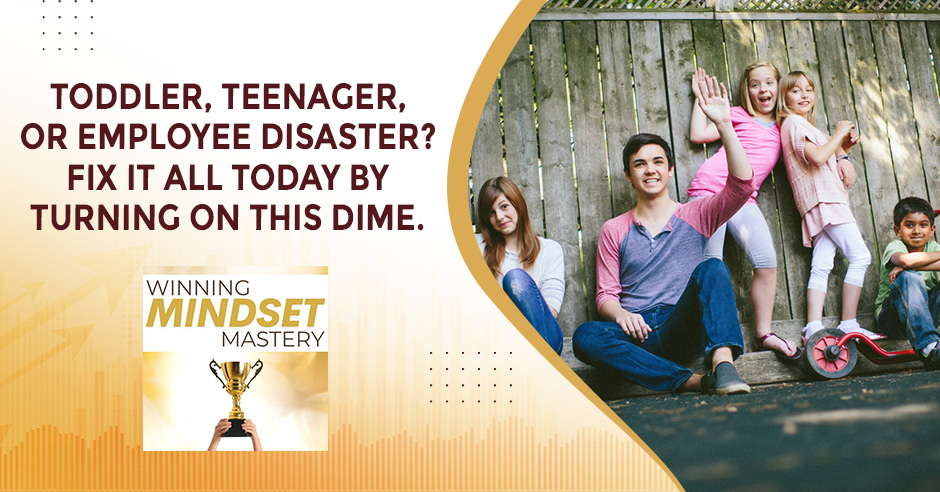
If you listen to this podcast regularly, you understand that I’m a big believer in reframing. But here’s something you may not have thought about: the power of reframing for teenagers and young children. Reframing isn’t only for adults. It’s just as valuable for kids, too. You give them a wonderful advantage when you teach them about reframing. And unlike a lot of adults, they pick it up quickly. Here’s a bonus: when you teach your kids to reframe, they just might help you get better at it yourself! But here’s the thing: When you’re teaching a child to reframe, especially if you’re dealing with a child with behavior issues, it’s easy to focus on the wrong things. So how do you do it correctly? April tells you in episode 26 of the Winning Mindset Mastery Podcast!
—
Listen to the podcast here
Toddler, Teenager, Or Employee Disaster? FIX It All TODAY By Turning On THIS Dime
I bring a situation to you and reframe it to help you with your reframing practice because it is so powerful for your mindset. If you haven’t happened to hear me talk about reframing before, reframing is looking at a situation in a new way through a different lens that allows you to feel empowered and at peace with how to move forward. A lot of times no matter what has happened to us, reframing the situation can change everything about it and how ready you feel to handle it and move forward.
I’m going to give you an example of reframing for a teenager or a kid. This is super powerful for a lot of reasons. One, parenting is a job that requires so much knowledge and patience, not unlike leadership. You have got to find ways to speak to people and help them understand in a way that resonates with them. The second reason is that no one picks things up quicker than children and teenagers. What an incredible advantage you give the children and the teenagers in your life if you teach them to reframe from a young age. They will probably help you get better at it too.

Reframing: Parenting is a job that requires so much knowledge and patience, not unlike leadership.
This reframe comes from a psychologist friend of mine who was working with a girl in high school who had a lot of behavioral problems at school. She had both ADHD and family issues at home. They were manifesting as behavior issues in the school. She was sent to this particular psychologist who did some remarkable reframes that were very simple for her, and it made such a difference. It was as simple as when the young girl was describing to her the different things that happened saying, “It sounds to me like you’re unhappy. You want to be happy, and you want your life to be better.”
Let’s think about what that would look like. If your life was as close to perfect as you can imagine it, what would that experience be like? That may seem overly simplistic but let’s break it down for a moment. Why this is so powerful is when you’re dealing with a child that people have labeled a troubled child, or they’re causing issues or even your child, you tend to latch onto and focus on the negative behavior that you don’t want, and that’s what you talk about.
The thing is that with your mindset, you’re going to get what you focus on. You don’t want to focus on that negative behavior. You want to focus on the behavior that you want. When you focus on their negative behavior, anyone gets defensive, kids especially, if it’s a person in authority that’s focusing on that negative behavior. Instead of focusing on all the things that particular child is doing that you don’t want, that isn’t serving them, and that isn’t a good idea, reframe it very simply to say, “I know you would like this to be better.” That is a statement saying you know that they’re doing the best that they can and then asking them, “What would this look like if it was the perfect life for you?”
With mindset, you get what you focus on, so don’t focus on negative behavior. Focus on the behavior that you want. Share on XThat is changing their perspective. Instead of focusing on failure, they’re focusing on a better future. You have changed their mindset to focus on what they want, not what they don’t want. Remember, especially when you’re dealing with a teenager, they so often feel misunderstood that taking those few moments to share that you do understand and see the things that they want can be incredibly powerful. This technique also works as a leader.

Reframing: When you’re dealing with a teenager, they so often feel misunderstood that taking those few moments to share that you do understand and see the things that they want can be incredibly powerful.
It’s great with kids. I love people to start it as young as possible because the younger you start, the better you are also from a leadership perspective, especially if you’re inheriting a team. Let’s say that you’ve got some folks. As you’re observing, you come in. In those early stages, you may not be saying a lot but you’re watching. You see those folks who for whatever reason seem like they’re not performing up to standard. They’re not responsive. They’re snappy. They aren’t getting their deliverables done and those sorts of things. There could be an exceptionally good reason for that.
Especially as a new leader, you have a great opportunity to come in and reframe the situation that they’re in to get answers that can help you make a tremendous difference, not only in their job and their area of the company but for everyone because if you come to a person who’s under a lot of stress and who isn’t performing the way that they would also like to perform and say, “I notice that you care about what you’re doing. It seems like you can’t always do this to the level that you want to but I know that you do. What are the things that you feel like get in your way that you think I can help with?” You’re not making them wrong. You’re telling them that you see that there’s a struggle, and you want to help.

Reframing: A leader’s biggest job is to clear obstacles, empower people, and allow them to shine.
You’re not making the struggle that they are doing things badly. This is a way that I use in my business to uncover process problems and to uncover when there’s a manning issue, meaning they don’t have enough staff to do the things that they’re trying to do. You can very quickly through a simple reframe help that person feel better about where they are in their role and also help them feel like they can open up to you and share where the challenges are so that you can fix them. Let’s be clear. As a leader, that is our biggest job. Clear the obstacles, empower our people, and allow them to shine. I hope you like this reframe. I can’t wait to hear how it’s worked for you. Here’s to your success.





